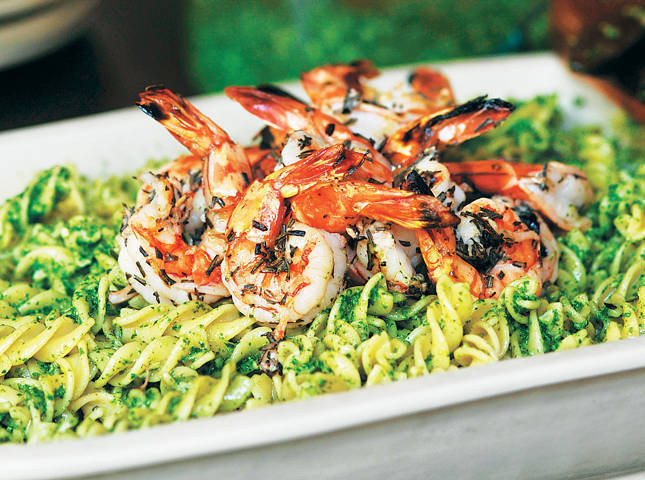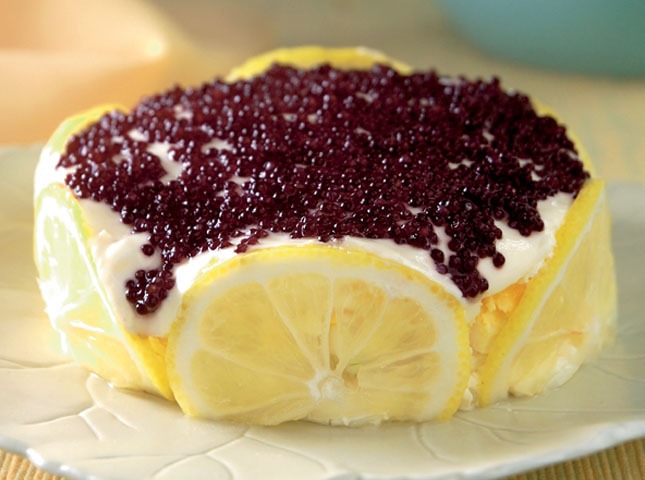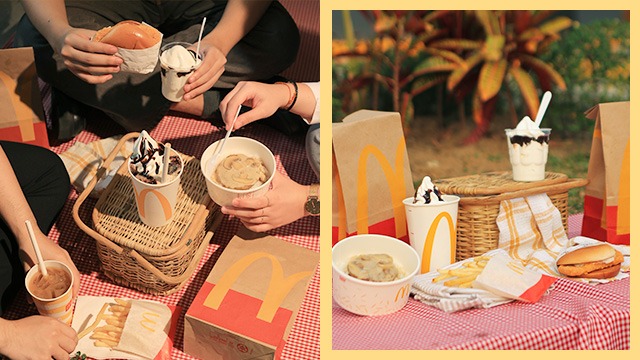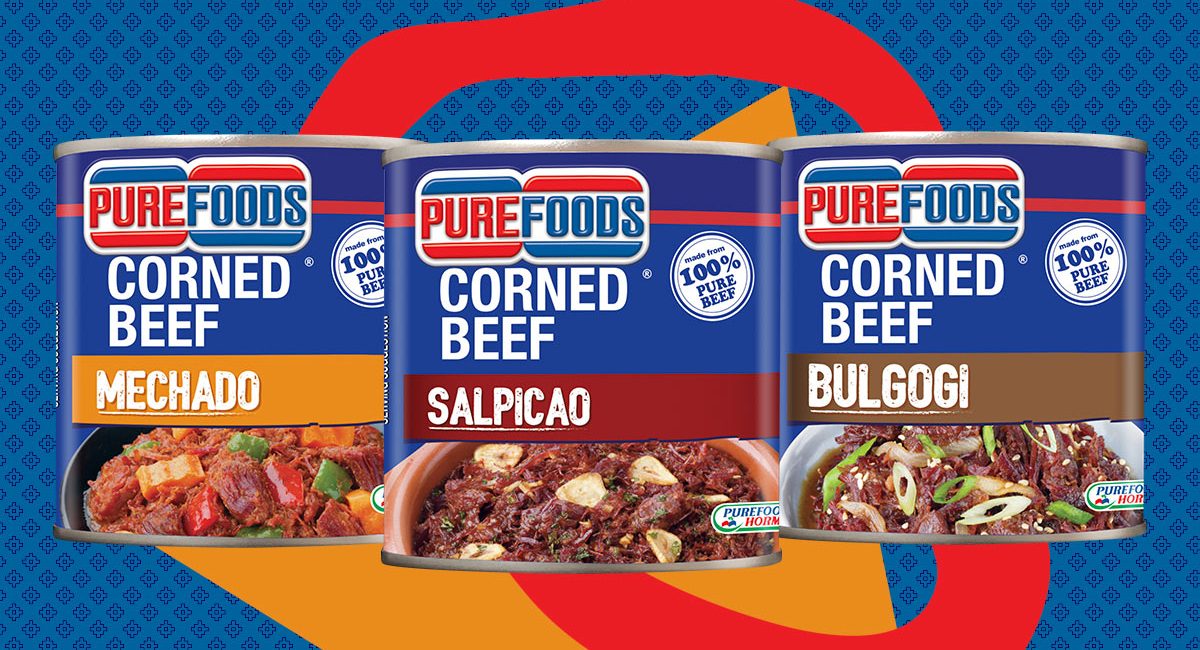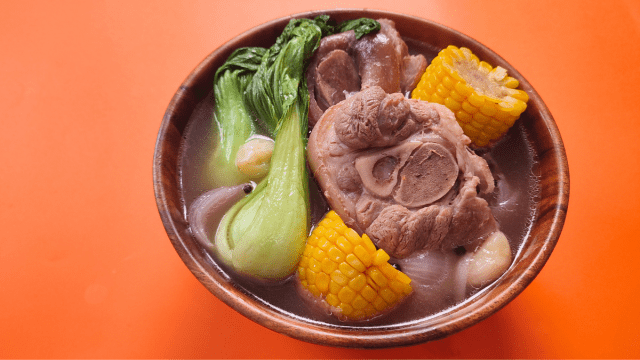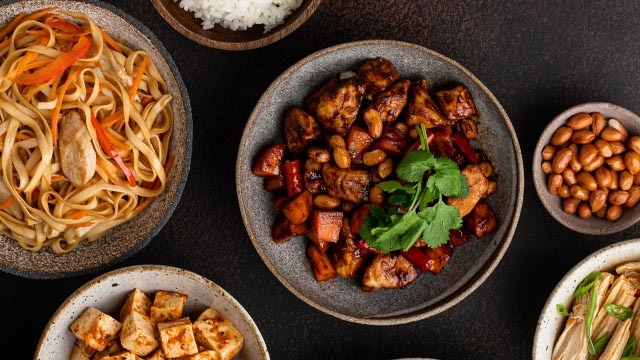
What is Chinese Food?
Chinese food is one of the most recognizable in the world: go to any bustling metro in the world and you’re likely to find a local Chinatown. From the savory chow mein to juicy dim sum and even sweet treats like tanghulu (candied fruit), Chinese cuisine has captivated the world not just with its unique flavors, but also how easily and conveniently Chinese dishes can be prepared. So convenient, in fact, that it’s hard not to associate Chinese food with takeout!

Just like its country of origin, Chinese cuisine is so vast that it can actually be broken down to eight of its most prominent regional cuisines: Anhui, Cantonese, Fujian, Hunan, Jiangsu, Shandong, Szechuan, and Zhejiang. Out of these, Cantonese and Szechuan may be the most popular. Cantonese food, which is known for dishes like char siu and smoked duck, features mild, fresh, slightly sweet flavors. Meanwhile, Szechuan cuisine is known for dishes like kung pao chicken and mapo tofu, which feature a numbing and spicy mala flavor (ma means numbing, and la means spicy).
Some Chinese food staples include noodles, stir-fried dishes, rice, tofu, chili oil, and various seasonings that give Chinese dishes their signature taste and aroma. Chinese cuisine is inspired not only by the geography of its regions; it is also steeped in history and culture, with many dishes having origins and meanings tied to traditional or historical events.
Common Chinese Food Terms

Here are some Chinese food terms you might encounter when you’re ordering at your favorite Chinese restaurant. While the Chinese characters for most of these terms are the same, different Chinese dialects pronounce it differently. This collection lists the most popularly used pronunciations in the Philippines, but we’ve also included the pronunciations used by other Asian and Western countries (the dialects are noted in parentheses).
Bao
“Bao” (Mandarin) can refer to sweet steamed buns filled with meat or vegetables. The Philippines also has a version of bao, called siopao, which originates from the Cantonese siu bao, and is usually filled with pork asado (a localized version of the Chinese char siu), or bola-bola (meatballs).
Recommended Videos
Bao can also refer to dumplings, as in xiao long bao (soup dumplings).
Cha
“Cha” (Mandarin) means tea. Some of its most popular variants include: hongcha, which literally translates to “red tea” but actually refers to black tea, wulongcha or oolong tea, molihuacha (pronounced mwoh-li-hwa-cha) or jasmine tea, and of course, naicha, or milk tea.
Chao
“Chao” means stir-fried. If encountered on a menu, items that begin with “chao” are usually stir-fried, like chao mian (pronounced chow-miyen), which is also more popularly spelled as “chow mein,” and chao fan or fried rice (“fan” means rice).
In the Philippines, where the Fujian dialect is also spoken, some dishes may begin with “cha” instead of “chao.” Some examples that use the Fujian pronunciation are chami (stir-fried thick egg noodles) and cha misua (stir-fried wheat vermicelli noodles).
Char Siu
“Char Siu” (Cantonese) or “Cha shao” (Mandarin) is Chinese barbequed pork, usually tinted red from the red yeast rice in its marinade, along with sweeteners and five-spice powder.
The Philippines has a localized version called the pork asado, but instead of being grilled, the Chinese-Filipino asado is braised or roasted in an oven. It can also be called “cha siu,” which is the Fujian pronunciation.
While char siu also bears close ties with the Japanese chashu, the key difference is that chashu is made with a slab of pork belly rolled into a log, and marinated without five-spice powder or the red yeast rice. Chashu is also braised instead of grilled.

Chopsuey
“Chopsuey” is the Americanized name of the Chinese stir-fried vegetable dish, za sui (Mandarin, pronounced “tsa-sway”). Za means “miscellaneous” while sui means “vegetables.” In the Philippines, it can also be referred to by its Fujian pronunciation, “chap chye” (pronounced “tsap tsai”).
Congee
“Congee” is the blanket term for Asian rice porridge or gruel; usually referring to Chinese porridge. Unlike the rest of this list, congee actually comes from the Tamil word kanji, which translates to “boilings,” or the water in which rice has been cooked.
In Chinese, congee is called zhou (Mandarin) or juk (Cantonese), and is usually served with a side of braised meat, century egg, and pickled vegetables.
Dim sum
“Dim sum” (Cantonese) or “Dian xin” (Mandarin) are small steamed or fried dishes, which can be sweet or savory bites. Its literal translation is “to lightly touch the heart,” and is usually eaten as a light snack.
Savory dim sum include dumplings like xiao long bao or siu mai (Cantonese), which is a popular dim sum in the Philippines. Locally, siu mai is more popularly known as siomai (Fujian) and they are usually made with pork and shrimp.
Dim sum can also be sweet, and some examples include jiandui, which are fried sesame balls filled with sweet mung bean paste (popularly known in the Philippines as buchi), and danta or egg tarts, which are closely related to Portuguese egg tarts.
Egg Foo Yong
“Egg Foo Yong” (Cantonese, also spelled foo young or fu yung) or “Fu Rong Dan” (Mandarin), means hibiscus egg. and is a kind of omelet filled with vegetables like beansprouts, cabbage, spring onions, mushrooms, and water chestnuts. It can also be made with meat and seafood like shrimp or crab, and is usually served with a glossy brown gravy.

Hongma
“Hongma” (Fujian) or “Hongshaorou” (Mandarin, pronounced hong-shao-row) is a pork dish braised in sugar, soy sauce, star anise, and other aromatics. “Hong” means red, and “shao” means braised, and “ma” or “rou” means meat. This dish is called “red braised meat” due to the color that the caramelized sugar and soy sauce gives the pork.
The Philippine version of this is called humba, which is made similarly but uses less aromatics and adds banana blossoms and wood-ear mushrooms.
Hot Pot
Hot pot or hotpot is called “huo guo” in Mandarin Chinese, and translates literally to “fire pot.” Hot pot-style meals usually involve having a pot filled with soup stock simmering on a portable stove, and diners can boil thinly-sliced meat, seafood, dumplings, meat or seafood balls, vegetables, noodles, and tofu as they eat.
Condiments like hoisin sauce, sesame oil, garlic, scallions, chopped onions, chopped chilis, soy sauce, and XO sauce, among others, are served on the side, and diners can also combine these to make a dipping sauce or add them into the stock, depending on their personal preference.
Kuchay
“Kuchay” is the Filipino term for “jiu chai” (Mandarin, pronounced chee-yow chai) or “ku chai” (Fujian, pronounced “koo-tsai”), which are Chinese chives. Kuchay are usually used to make kuchay dumplings, which are dumplings filled with savory ground pork and Chinese chives.
Kung Pao Chicken
“Kung Pao Chicken” is a spicy stir-fried cubed chicken dish that has vegetables, peanuts, and chili peppers. In Mandarin, it’s called “Gong Bao Ji Ding” (pronounced “kong-pao-tsi-ting”), and is believed to be named after Ding Baozhen, a Qing dynasty official. “Gong bao” means palace guard, “ji” means chicken, and “ding” means cubed, which is also a play on the official’s name and the way the chicken meat is cut.

Ma la
“Ma la” (Mandarin) refers to the numbing yet spicy taste that is unique to Sichuan peppercorns. It is used in Szechuan dishes like kung pao chicken and mapo tofu.
Mantou
“Mantou” (Mandarin) are plain steamed buns. They may also be fried, and are usually served a side dish to savory dishes like hongma. It can also be served as a dessert or snack with a side of condensed milk to dip in.
Pidan (Century Eggs)
“Pidan” (Mandarin, prounced “pi-tan”) may be popularly known as century eggs, but “pi” actually means “leather or skin” while “dan” means “eggs.” The term century eggs is a misnomer; these eggs do not actually take 100 years to make! In fact, it only takes several weeks to several months. The eggs, which are usually duck but can also be chicken or quail, turn black as they are preserved in a mixture of clay, ash, salt, quicklime, and rice hulls.
Potstickers
Potstickers is the American name for Chinese dumplings called “jiaozi.” While jiaozi are usually steamed, legend has it that potstickers were invented by a Song dynasty chef who left the dumplings in the pot for too long, which toasted the bottom but steamed the top.
Potstickers are a kind of dumpling, and are closely related to the Japanese dumplings called gyoza, which are cooked in the same way.
Wonton
“Wonton” (Cantonese) or “Huntun” (Mandarin) are a type of dumpling. Wonton literally translates to “irregularly shaped dumplings” and unlike jiaozi, which are expected to be beautifully folded with creases in its wrapper, wontons have simpler folds, and is shaped to look like ancient Chinese gold ingots.
Essential Chinese Cooking Ingredients

Misua
Misua are thin wheat vermicelli noodles that are used in Chinese noodle stir-fries or noodle soup dishes.
Ho Fan
Ho fan are thick flat noodles that are usually featured in ho fan dishes: stir-fried noodle dishes that also have chopped vegetables and meat or seafood tossed in a savory sauce.
Shaoxing Wine
Shaoxing wine is a Chinese rice wine that is produced Shaoxing City, in China’s Zhejiang Province. It is yellowish-brown color, and is made by fermenting glutinous rice, water, and wheat-based yeast. Shaoxing wine has a unique flavor and is slightly sweet, and adds a mild but complex flavor to Chinese dishes, congee and steamed fish dishes.
Five-spice Powder
Chinese food uses a lot of aromatic spices, and five-spice is one of the most prominent ones. Five-spice powder is composed of ground star anise, clove, Chinese cinnamon, Sichuan pepper, and fennel seeds.
Hoisin Sauce
Hoisin sauce is a thick, fragrant, dark brown dipping sauce. It is can be used as a condiment, served on the side as a dip for meats like smoked duck or char siu, or to add a deep, anise-like flavor to marinades and braised and stir-fried dishes.

Douchi (Tausi or Taosi)
Douchi, or Tausi/ Taosi, as it is locally known in the Philippines, are fermented black soybeans. Tausi are fermented with salt, which results in a salty yet complex soybean flavor. These are readily available in groceries or Asian supermarkets.
Yummy Editor Tip: Tausi are VERY salty! When using in a recipe for the first time, you can try tasting them so that you can adjust your dish’s seasoning (you can reduce either the amount of soy sauce, oyster sauce, or salt in the recipe). Alternatively, if you really want to reduce the saltiness, you can give the tausi a quick rinse before adding them to your dish.
Sesame oil
Sesame oil is used to finish a lot of Chinese dishes. Unlike other vegetable oils, sesame oil evaporates much more quickly, which is why it isn’t ideal for frying and is usually added towards the end of cooking: so as to preserve its aroma and taste. It can also be used as an ingredient in marinades.
Black vinegar
Chinese black vinegar is made from glutinous rice, and has a smoky, malty flavor. It is less sour than white coconut vinegar, and is not only used as a flavoring agent; it is also usually mixed with soy sauce to make dips for dim sum.
Szechuan peppercorns
Szechuan or Sichuan peppercorns originate from China’s Sichuan province, and it is what gives Szechuan cuisine its signature ma la flavor. These peppercorns pack some heat (although they are less spicy than bird’s eye peppers or siling labuyo), and have a distinct numbing effect when consumed.
Doubanjiang
Doubanjiang is fermented chili bean paste. It is also a staple of Szechuan cuisine, and is made with fermented broad beans, soybeans, chili peppers, and salt. It is used in dishes like mapo tofu, and can also be used as an ingredient in char siu marinades.
XO Sauce
XO Sauce is more like a paste made with dried shrimp and scallops, pork, shallots, garlic, chili, and other aromatics. While XO sauce does not contain alcohol, it was treated like a luxury condiment in Hong Kong, where it originates; hence, it was named after a French cognac to connote its high quality.
Oyster Sauce
Oyster sauce, as the name suggests, is made from oysters, but its flavor is deepened by the addition of soy sauce, sugar, and salt, and it is thickened with cornstarch. Oyster sauce adds a salty and sweet seafood flavor to Chinese dishes.
Chinese Kitchen Essentials

Most Chinese dishes can be made with basic kitchen tools and equipment, but here are some tools that can make your experience in cooking Chinese food easier.
Wok
Woks are deep, round-bottomed cooking pot that is traditionally used in cooking Chinese food. It can be made from carbon steel, cast iron, or aluminum. Its shape makes it easy not only to stir-fry food; it can also be used to deep fry or even serve as a steaming pot.
Bamboo or Stainless-Steel Steamers
From dim sum to seafood and even meat, there are many Chinese dishes that are steamed, so having bamboo or stainless-steal stovetop steamers are a handy addition to any kitchen.
Bamboo strainer
These strainers make it easy to scoop out deep-fried food, and the bamboo handle ensures that you won’t burn yourself while straining them out!
Fine mesh strainer
It’s important to skim off the scum that floats in braised or boiled Chinese dishes, and fine mesh strainers are great at doing just that.
Rice cooker
Aside from chao fan (fried rice) being one of the most popular Chinese food, so many other Chinese dishes go well with rice! If you often cook Chinese food, it just makes sense to have a rice cooker in your kitchen.
Hot pot
Hot pots are heavy bottomed ceramic pots that you can put over a stove. What makes them so special is that these ceramic pots distribute heat evenly, so you can enjoy your hotpot without worrying about the broth or other ingredients getting too hot or burnt.
Food processor
Chinese cuisine uses a lot of aromatics, and these are usually spices that are toasted and ground. While most of them can be bought in their powdered form at the grocery, you can also use a food processor to make your own mix at home!
Chinese Dimsum Recipes
Dim sum or dimsum are usually eaten as snacks or light meals. The dumpling-type dim sum in this list are best enjoyed with a dipping sauce made by combining soy sauce and black vinegar (and optionally, chili oil).

• Pork and Shrimp Siomai Recipe (You can also check out more siomai recipes here.)
• Pork Dumplings in Garlic-Cilantro Sauce Recipe
• Pork and Chives Dumplings Recipe
• Chicken Feet with Black Beans Recipe
• Steamed Pork Spareribs with Tausi Recipe
• Salt and Pepper Spareribs Recipe
Chinese Appetizer or Side Dish Recipes
These Chinese dishes are usually shared, and are served in small portions to serve as appetizers or side dishes.

• Chinese Pork Lettuce Wrap Recipe
• Bok Choy in Oyster Sauce Recipe
Chinese Noodle Recipes
Noodles are one of the staples of Chinese food, and not only is there a wide variety of different kinds of noodles; there’s also so many ways to cook them! Be careful when picking up noodles at your local Asian market, because some of them are better suited as stir-fries, while others are amazing in soup dishes.

Stir-fried Noodle Recipes
• Family-Style Chinese Pancit Recipe
• Chinese Birthday Noodles Recipe
• Stir-fried Beef Mushroom Noodle Recipe
• Chicken and Shrimp Crispy Egg Noodles Recipe
• Garlic Shrimp Lo Mein Recipe
Chinese Noodle Soup Recipes
• Chicken and Prawn Wonton Noodle Soup Recipe
• Misua Seafood Noodle Soup Recipe
• Beef and Dumpling Noodle Soup Recipe
Chinese Roasted Recipes
These Chinese roasts are not only charred to perfection; they are irresistably delicious because of their flavorful and aromatic marinades.


